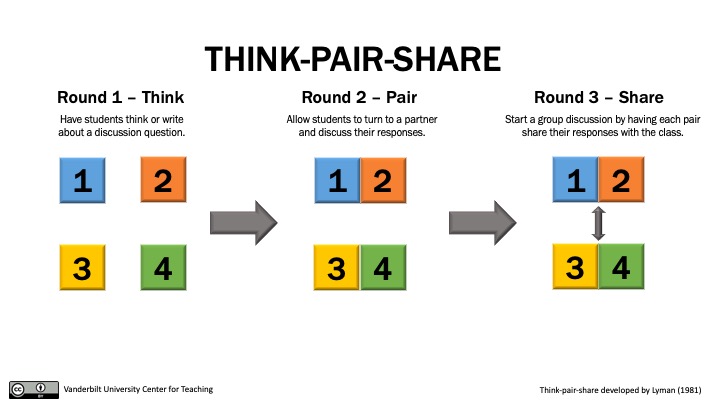Encouraging student collaboration is one of the best ways of helping students learn about each other and from each other. Collaboration in the classroom can take many forms, but often will involve group work to teach one another while the instructor can serve as the “guide on the side”.
Ideas for a Face-to-Face Class
Here are a few ideas to get started with student collaboration in a face-to-face class:
Think-Pair-Share
In this classic teaching technique, the instructor asks students to individually first think about a topic and generate their own responses. Individual students are then paired with another student to discuss their responses and potentially discuss a related topic. Pairs are then asked to share out to the group or a different pair.

Jigsaw
Students are broken into groups of equal numbers and are given a task that requires them to become experts on it – this may revolve around a question, a piece of content, or something different. Same-question groups are then broken down, with students assembling into new groups where each individual member comes from a different question group. Students then share their knowledge with one another and discuss.

Group Presentations
Asking students to work together to present concepts to the classroom is an effective way of adding collaboration to student interactions. Students are often asked to team up in groups, either determined by the instructor or by the students themselves, with an objective to complete. In many instances, students are asked to create a Microsoft PowerPoint/Google Slides/Apple Keynote slideshow and divide research and speaking roles.
While group presentations often use the typical slideshow instructors can instead leverage different ways of having students present content. Students can be offered the opportunity of presenting content in a manner that most relates to them. This may result in students using a standard slideshow, creating a video, developing an infograpghic, or more. This also helps students work in a medium in which they are familiar, allowing them to express their own skills and thinking while accomplishing the needs of the task.
Debates
Debates among students are a great way of reviewing all aspects of a topic. Debates are often used to discuss concepts such a medical issues, historical decisions, political and/or societal questions, and more. In many cases the class is broken up into two or more teams, each handling a specific position on a question. Students on each team must review content related to their question and define the reasoning of their positon. Students ultimately debate the differing aspects of the question, leading to an increase in their critical thinking skillset.
Debates can also happen in quick order, particularly when using current topics. All debates need a level of structure and rules to prevent tangential discussions or discussions that may cause classroom discord.
Technology to Help
Here are a few tools that may help enhance student collaboration through technology:
Google Docs/Sheets/Slides
Google’s suite of tools allow for easy collaboration among individuals. This allows groups of students to work together on documents, spreadsheets, and presentations, while also tracking their contributions. Students would need to have a Google account to proceed, and the faculty member would need one if monitoring student work.
Canvas Groups
The Groups tool within Canvas can assist in grouping together students for various tasks. Students can then be graded based on their group efforts. Groups can be leveraged on most graded tasks within Canvas, including assignments, discussions, and collaborations. Groups also give students their own area to work together within the system.
Canvas Collaborations
The Collaborations tool within Canvas can connect both Canvas Groups and Google Docs/Sheets/Slides. The tool enables connecting together individuals on a singular document, spreadsheet, or slide without having to share each other’s contact information. The same tool also allows for instructor oversight of collaborative documents. As with any Google tool, a Google account is required to proceed.
Questions? We can help!
Have questions about instruction, course design, teaching methods, technology to help, or more? Please contact the Center for Teaching & Learning through our contact form or by phone at (708) 974-5347.
Additional Information
- Group work: Using cooperative learning groups effectively – Vanderbilt University, Center for Teaching
